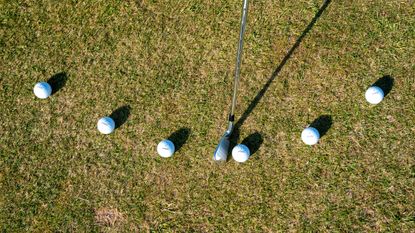How To Check Your Swing Path
Kevin Craggs demonstrates a simple drill that will help you check if you're swinging on plane


It goes without saying that the swing path has a massive impact on the ball flight. Too much out-to-in will lead to an over-the-top swing that causes a slice, and too much in-to-out is one of the reasons many people struggle with hooking the golf ball. But before you can set about fixing these flaws, it's vital first to diagnose the problem. In the video and article below, PGA pro Kevin Craggs shares his simple tips on how you can check your swing path...
There are very few golfers, even at the highest level of the game, who can boast a perfect swing path. It is also true to say that there are plenty of examples of players who have reached the top of the world game without having a textbook swing plane. But not knowing your swing tendencies is likely one of the reasons you don't get better at golf, such is its importance.
That being said, I certainly wouldn’t want you to become preoccupied with ‘placing’ the club in the right position during the swing. However, I do think it’s a good idea to use this drill from time-to-time to ensure you aren’t straying too far from the right line.
This simple drill explains how to check your swing path and will help you feel the correct positions at various points throughout the swing in order to get the club more on plane.
Find an old club, stick an alignment aid in the end and then place two clubs on the ground parallel to your target line. Take your normal address position and then slowly swing back. Stop halfway back – the stick should be parallel to the clubs on the ground.
Then continue swinging – the end of the stick should point to the clubs on the ground as you make your way to the top of the backswing and as you start down. Halfway through the downswing the alignment stick should be parallel to the shafts on the ground.
As mentioned, you are unlikely to be on the perfect line every time you swing but using this drill occasionally will help you stay on track for more consistently accurate shots. If your swing plane changes and you start to get very flat or very steep, this is when poor shots will come in so this drill is great to use at certain points in the season. The benefit for your long game will be huge!
Get the Golf Monthly Newsletter
Subscribe to the Golf Monthly newsletter to stay up to date with all the latest tour news, equipment news, reviews, head-to-heads and buyer’s guides from our team of experienced experts.
Watch out!
If, when you reach the top of your backswing, the alignment stick is pointing well to the left or the right of the shafts on the ground, you will have problems squaring the clubface at impact.
If you are a long way out here, some timely advice on how to fix the issue from your local pro is a very sensible move.

A lifelong golf fan, Andy graduated in 2019 with a degree in Sports Journalism and got his first role in the industry as the Instruction Editor for National Club Golfer. From there, he decided to go freelance and now covers a variety of topics for Golf Monthly.
Andy took up the game at the age of seven and even harboured ambitions of a career in the professional ranks for a spell. That didn’t pan out, but he still enjoys his weekend golf at Royal Troon and holds a scratch handicap. As a side note, he's made five holes-in-one and could quite possibly be Retief Goosen’s biggest fan.
As well as the above, some of Andy's work has featured on websites such as goal.com, dailyrecord.co.uk, and theopen.com.
What's in Andy's bag?
Driver: Callaway Mavrik Sub-Zero (9°)
3-wood: TaylorMade Stealth 2 Plus (15°)
Driving iron: Titleist U500 (17°)
Irons: Mizuno mp32 (4-PW)
Wedges: Titleist Vokey SM9 (50°, 54° and 58°)
Putter: Titleist Scotty Cameron Newport 2.5
Ball: TaylorMade TP5x
-
 5 Things We Learned From Greg Norman's LIV Adelaide Press Conference
5 Things We Learned From Greg Norman's LIV Adelaide Press ConferenceThe Shark weighed into a number of the game's major talking points ahead of the LIV Golf Adelaide event
By Andrew Wright Published
-
 YouTube Star George Bryan Comes Within Inches Of PGA Tour Start At Qualifying Event
YouTube Star George Bryan Comes Within Inches Of PGA Tour Start At Qualifying EventThe YouTube star appeared set for a place at the Myrtle Beach Classic, but a near miss on the 18th left him in a playoff, which Matt Atkins won
By Mike Hall Published